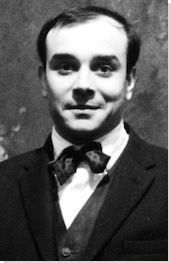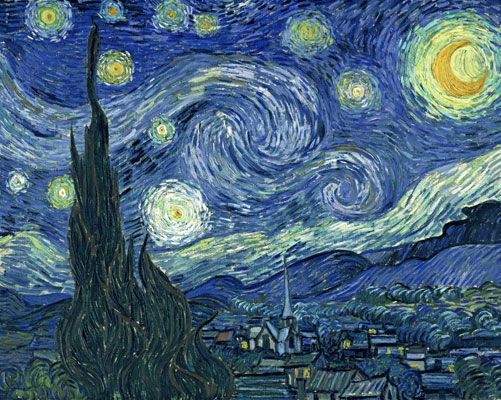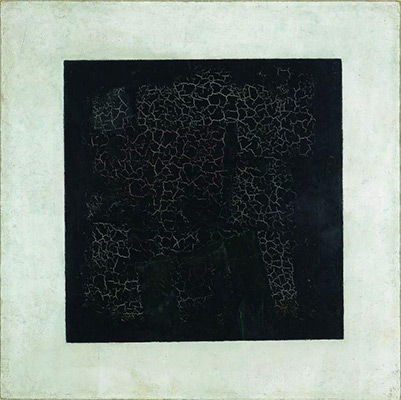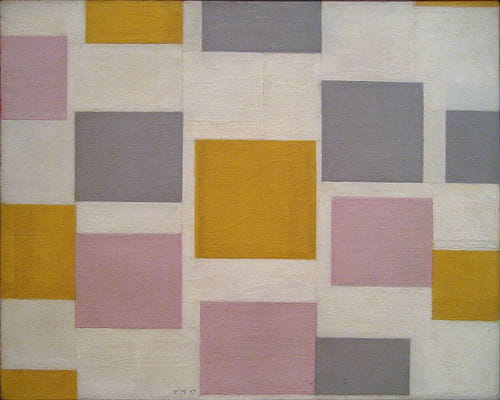Summary of Yves Klein
Yves Klein was the most influential, prominent, and controversial French artist to emerge in the 1950s. He is remembered above all for his use of a single color, the rich shade of ultramarine that he made his own: International Klein Blue. But the success of his sadly short-lived career lay in attacking many of the ideas that underpinned the abstract painting that had been dominant in France since the end of the Second World War. For some critics he is a descendent of Marcel Duchamp, a prankster who lampooned settled understandings of painting and opened art up to new media. Others consider him as a descendant of earlier avant-garde artists such as Kazimir Malevich and Aleksander Rodchenko, who were also attracted to the monochrome. And even in the ways he used performance later on in his career, he is like many artists who rediscovered some of the tactics of earlier avant-gardes in the 1950s and '60s. Klein might also be compared to his contemporary Joseph Beuys, for, like Beuys, he embraced aspects of Romanticism and mysticism - Klein was intrigued by Eastern religion and Rosicrucianism, and was even influenced by judo. Also like Beuys, many have condemned him as an obscurantist and a charlatan: yet the brevity, wit, and seductive beauty of much of his work continues to inspire.
Accomplishments
- The abstract painting that dominated French art in the 1950s was invariably premised on the notion that an artist could communicate with the viewer through the power of abstract form. But skeptics of modern, abstract art have always alleged that the viewers, like the faithful devotees of a false god, do more of the work than the artist, investing the forms with their own feelings rather than discovering the artist's. Viewed in this light, Klein's monochrome blue paintings might be read as a satire on abstract art, for not only do the pictures carry no motif, but Klein insisted there was nothing there at all, only "the void."
- Klein's pictures may also be read in a contradictory fashion. He was genuinely fascinated by mystical ideas, by notions of the infinite, the undefinable, the absolute, and his use of a single rich and suggestive tone of blue might be seen as an attempt to free the viewer from all imposed ideas and let their mind soar. For, as Klein believed, lines in pictures were a form of "prison grating," and only color offered the path to freedom.
- Throughout Klein's work, from his canvas monochromes to his later performances, there is a stress on immediate experience that reflects aspects of the Performance art movement of the 1960s. Although he was never specifically opposed to creating art objects, many of Klein's later works seem to want to abandon the object as a vehicle for art and instead find ways to more directly transmit ideas and experiences.
Important Art by Yves Klein
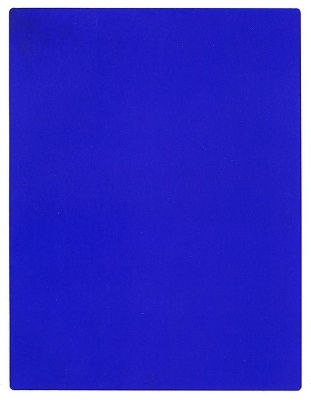
Blue Monochrome
This is one of Klein's first monochromes featuring International Klein Blue. He reported that, at the age of nineteen, he looked up at the sky and realized the infinite, immaterial space surrounding the universe. To depict his vision, he chose to use only one color, a vibrant shade of ultramarine, which he later perfected for use with the aid of chemists. The painting contains no trace of line or imagery, encouraging the viewer to immerse herself in the color alone and to experience its evocations. Symbolic, perhaps, of the sky and the sea, it also had resonances in Klein's own religion, Catholicism, as not only a symbol of the Holy Ghost, but also as the shade traditionally used in the depiction of the Virgin Mary's robes in Renaissance paintings.
Dry pigment in synthetic polymer medium on cotton over plywood - The Museum of Modern Art, New York
Le Vide
To further his artistic vision of the immaterial, Klein created Le Vide (The Void), removing everything from the Iris Clert Gallery except for an empty cabinet. Klein also created a dramatic entrance for the opening ceremony, in which visitors were welcomed into the empty room. Regarding the work Klein stated, "My paintings are now invisible and I would like to show them in a clear and positive manner..." Although the stunt might be read as part of Klein's ongoing interest in mysticism and "the void," like much of his work it might also be read in a slightly contradictory manner, as a political attack on the traditional art object and the gallery system that supports it.
Installation with cabinet - Displayed at the Iris Clert Gallery, Paris
Le Saut dans le Vide (Leap into the Void)
This controversial photomontage was constructed by Klein by collaging his falling body onto an image of a street. From a young age, he had stated that he possessed the power to levitate, here, we see him attempting to defy gravity. The physicality of the performance might have been inspired in part by Klein's judo training, but it might equally have been inspired by his attitudes to earlier artistic evocations of what he regarded as "the void." Speaking of a still life by the Russian Suprematist Kazimir Malevich, he once wrote, "Malevich was actually standing before the infinite - I am in it. You don't represent or produce it - you are it."
Photograph by Harry Shunk; performance by Yves Klein at Rue Gentil-Bernard, Fontenay-aux-Roses, France - Originally published in Dimanche - Le Journal d'un Seul Jour by Yves Klein
Venus Bleue (Blue Venus)
Here, Klein applies his signature International Klein Blue to a plaster cast of the famous Venus de Milo sculpture, pushing the monochrome into the three-dimensional field and establishing a relationship between the infinite cosmos and the human form. By appropriating the famous Greek sculpture and painting it IKB, Klein gives the dated masterpiece a kind of kitsch, commercial appeal, making it a precursor to Pop art (as Klein was at first an enthusiastic member of France's Pop movement, the Nouveau Realistes.) But the piece also prefigured his use of live nude women to create his Anthropometries series.
Pigment on plaster - Edition of 300
Relief eponge or (RE 47 II)
Although Klein is best known for his blue monochromes, he also used gold and red, which, together with blue, he regarded as representing the theological mystery of the Trinity. In this and related pieces, Klein used gold to direct the public to the cosmos; he believed that gold was symbolic of the absolute, divinity, and infinite space. Here he moves beyond the flat surface of a canvas by attaching a natural sea sponge and earthy pebbles to create a textured relief. The gritty quality, resembling a cratered planet, might also be intended to evoke the surface of the moon.
Sponges, pebbles and gold leaf on panel - Private Collection
Anthropométrie sans titre
After concentrating on the monochrome canvases, Klein made a new departure with his signature IKB color, using nude models as his brush. In the Anthropometries series, he covered nude females in blue paint and had them press, drag, and lay themselves across canvases to create bodily impressions. The piece was inspired in part by photographs of body-shaped burn-marks on the earth, which were caused by the atomic explosions at Hiroshima and Nagasaki. Klein crafted this idea into a performance piece, hosting a formal event where guests observed the nude models executing the piece. Although the events could be at times comic and bizarre, the resulting pictures represent a fresh and vivid approach to the idea of figurative painting, and one darkly influenced by the threat of the Cold War.
Oil on canvas on paper, resin - Musée Cantini, Marseille,France
Biography of Yves Klein
Childhood
Yves Klein was born on April 28, 1928, in Nice, France, to an artistic family; his mother, Marie Raymond, was a leading figure in the Art Informel movement, while his father, Fred Klein, painted figures and landscapes characteristic of the Post-Impressionists. Although Klein grew up in a creative household, he received no formal artistic training. The family lived in Paris between 1930 and 1939, but spent the summer months with artist friends in Cagnes-sur-Mer where Klein was left in the care of his aunt, Rose Raymond. She provided him with stability and a pragmatic outlook, a stark contrast to his parents' free-spirited attitude. These differing viewpoints, combined with his parents' artistic conflicts between figurative and abstract work, eventually led Klein to reject line and severely restrict color in his early work.
Early Training
Between 1942 and 1946, Klein studied at the École Nationale de la Marine Marchand and the École Nationale des Langues. During this time he became close friends with a young poet named Claude Pascal and a promising sculptor named Arman Fernandez. Together they shared common interests of judo (a modern martial art), jazz music, esoteric literature, and Eastern religions.
Klein's major artistic breakthrough occurred in 1947 while lying on a beach with Pascal and Arman. In the apocryphal account, the three friends divided the universe between themselves: Arman claimed the materiality of the earth, Pascal appropriated language and words, and Klein possessed "the void," or the planet empty of all matter. Klein embarked on a "realistic-imaginative" daydream into the depths of the universe, where he claimed to have inscribed his name in the sky. The symbolic gesture was a flashpoint in Klein's artistic pursuit to grapple with what he defined as the infinite.
Mature Period
The enlightening realization of the void in the sky led Klein to experiment in painting, performance, and music. In 1949, he created The Monotone-Silence Symphony, a piece containing a single chord sustained for twenty minutes followed by twenty minutes of meditative silence. The composition symbolized the sound pitch emitted from the monochrome blue sky (or "the void"), emphasizing universal harmony.
He lived in London with Pascal from 1948 to 1952, where he began to assist in the London frame shop of Robert Savage, learning gilding and basic painting techniques using raw pigments. In 1953, Klein traveled to Japan where he received a black belt in judo at the Kodokan Institute in Tokyo. There, he had a second private exhibition of monochromatic paintings and proclaimed The Manifesto of the Monochrome, in which he declared monochrome to be an "open window to freedom, as the possibility of being immersed in the immeasurable existence of color." Klein was determined to evoke emotions and sensations independent of line, rendered objects, or abstracted symbols, believing the monochromatic surface released the painting from materiality through the totality of pure pigment.
In 1956, Klein established himself in the Paris art scene with a controversial exhibition at the Galerie Colette Allendy titled Yves: Propositions Monochromes. Twenty monochromatic paintings were displayed, rendered in tones of blue, red, yellow, and orange. Klein received a disappointing reaction from the public, who viewed the exhibition as a new form of interior abstraction rather than an infinite journey into the immateriality of the surface. But Pierre Restany, an emerging French critic, immediately understood the sublime power of Klein's monochrome and supported him in expressing his viewpoint. After considering the public's misinterpretation at the Galerie Colette Allendy, Klein decided to push the monochrome a step further by focusing on his favorite color, blue.
Late Period
In 1956, with the assistance of a chemical technician, Klein succeeded in suspending his favorite ultramarine pigment in petroleum extracts, which allowed the pigment to maintain its brilliance and something of its powdery texture without dulling. He named the substance International Klein Blue (IKB). This marked the beginning of Klein's Blue Period, in which he produced several monochromatic paintings in the signature color, titling each International Klein Blue, combined with a serial number. Klein believed IKB was the perfect instrument with which to elaborate his belief in spiritual powers and the immaterial; ultramarine is the traditional symbolic color of the Holy Ghost in Christian religion and also evokes the expanse of the infinite sky and the depth of the oceans. In 1957, Klein exhibited 11 evenly spaced, vibrant IKB paintings at the Gallery Apollinaire in Milan. The paintings were displayed on poles, identical in size and structure but each bearing a different price, something that for Klein suggested the irrelevance of the material objects themselves and the importance instead of the viewer's response.
Klein took the concept of the immaterial a step further when he removed everything with the exception of an oversized cabinet from the Iris Clert Gallery in 1958. He believed that in emptying the gallery "the invisible [would] become effective through the perceptible." He titled the piece Le Vide (The Void), and created an intricate entrance ritual for the opening night.
In 1960, Klein renounced personal attachment to the picture plane by applying IKB with paint rollers and female models in a series dubbed the Anthropométries, the first of which was exhibited as a performance piece at the Galerie Internationale d'Art Contemporain in Paris. Nude female models slathered themselves in IKB and pressed their bodies against the gallery walls to create imprints. During this time, Klein became increasingly fascinated with natural elements and would incorporate fire, water, sea sponges, and gravel into his canvases and sculptures. This resulted in a series of fire paintings, monochromatic relief paintings, and IKB sculptures that expressed cosmological ideas of infinite space.
Klein received a poor response after he exhibited at the Leo Castelli Gallery in New York in 1961, where his paintings failed to sell, and he responded with the Chelsea Hotel Manifesto (1961) in which he explained his ideas. In 1962, he married artist Rotraut Uecker, which was several months before he died of a heart attack at the terribly young age of 34.
The Legacy of Yves Klein
In France, Yves Klein's quirky perception of reality was a significant forerunner of Nouveau Réalisme, a French strain of Pop art that was driven by the critic Pierre Restany, and which included Arman Fernandez, Martial Raysse, César Baldaccini, and Daniel Spoerri. His painting represents one of the most important responses to the monochrome in the 20th century and has joined the contributions of others such as Kasimir Malevich and Aleksander Rodchenko in defining the mode. Although, like similarly conceptual forerunners such as Marcel Duchamp, he has had few direct ancestors, his eccentric blend of mystical and materialist attitudes - his interest in the ineffable, and in the mechanics of the art market - has inspired many to believe that a lifetime as an artist can consist of all kinds of activity, from writing to painting to performing.
Influences and Connections

![Pierre Restany]() Pierre Restany
Pierre Restany![Claude Pascal]() Claude Pascal
Claude Pascal![Max Heindel]() Max Heindel
Max Heindel
-
![Jean Tinguely]() Jean Tinguely
Jean Tinguely -
![John Cage]() John Cage
John Cage ![Raymond Hains]() Raymond Hains
Raymond Hains
-
![Arman]() Arman
Arman ![Pierre Restany]() Pierre Restany
Pierre Restany![Claude Pascal]() Claude Pascal
Claude Pascal![Thomas McEvilley]() Thomas McEvilley
Thomas McEvilley![Dino Buzzati]() Dino Buzzati
Dino Buzzati
-
![Neo-Dada]() Neo-Dada
Neo-Dada -
![Nouveau Réalisme]() Nouveau Réalisme
Nouveau Réalisme -
![Performance Art]() Performance Art
Performance Art ![Monochrome Painting]() Monochrome Painting
Monochrome Painting
Useful Resources on Yves Klein
- Yves Klein: With the Void, Full PowersOur PickBy Kerry Brougher, Philippe Vergne, Klaus Ottmann, Yves Klein
- Yves Klein: 1928-1962By Hannah Weitemeier
- Yves Klein By HimselfBy Klaus Ottmann, Yves Klein
- Yves Klein: Works, Writings, InterviewsBy Klaus Ottmann, Yves Klein
 Ask The Art Story AI
Ask The Art Story AI